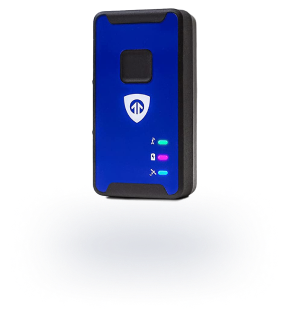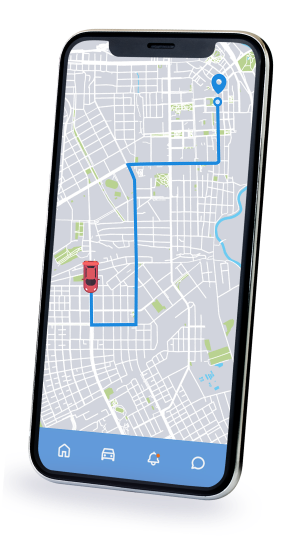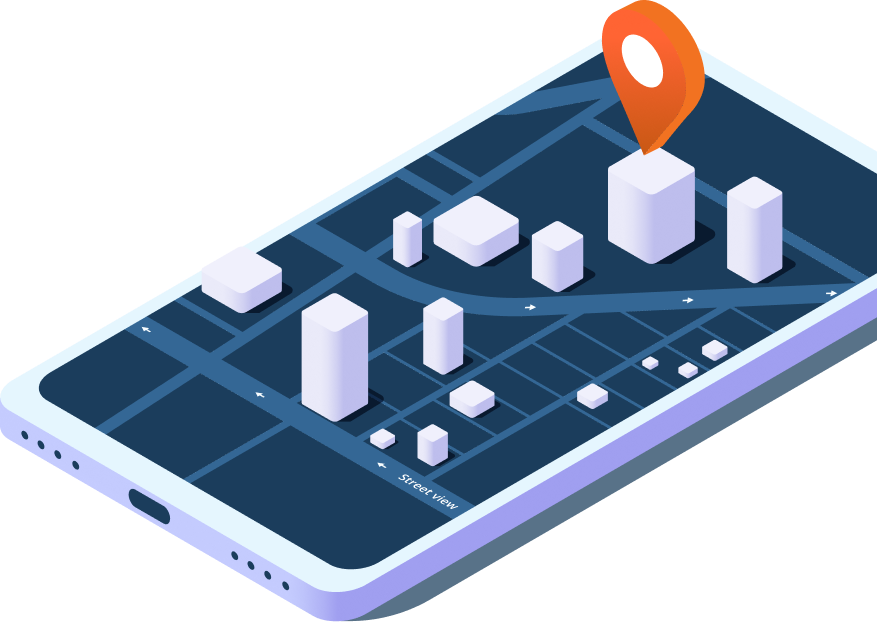How they work

AirTag
Short Range
Sends out a consistent, low-RF signal (e.g., Bluetooth). To track your asset more than a few dozen feet, you’ll need to rely on a large network of fellow customers opted into the tag provider’s network.

GPS Tracker
Long Range
Sends out a consistent, low-RF signal (e.g., Bluetooth). To track your asset more than a few dozen feet, you’ll need to rely on a large network of fellow customers opted into the tag provider’s network.
Data accessibility

AirTag
Individual Only

Because tracking tags are tied to individual smartphone users’ personal accounts, their data can be accessed only by those users. This is one example of how tags and tiles are designed for consumer use.

GPS Tracker
Multiple Users

GPS trackers’ real-time and historic data can be accessed online by anyone you set up with a user account on the GPS platform. This is one example of how GPS trackers are far easier than tracking tags for businesses to deploy and operate.
What they can tell you
AirTag
Not much...

Asset’s current location
(assuming you’re within a few feet)

Out of range alerts
and when you lose the asset’s signal
Not included
GPS Tracker
Lots of useful info!

Asset’s current location
(from anywhere in the world that has cell coverage)

Asset’s Historical Data
(where it’s been, when, how long, etc.)
For vehicles:

If an asset that is supposed to be stationery is moving
(e.g., to quickly alert your business about a theft and even help the police with retrieval)

Risky Driving Behaviors
including exceeding speed limits, rapid acceleration, and hard braking

Accurate ETAs
for your customers’ deliveries or arrival times of service reps

The vehicle’s current speed

The vehicle’s movement pattern over time
Find exactly what you’re looking for
Have keys or a bag you don’t want to misplace? A tracking tag should solve your problem.
But if you have costly assets to monitor – and you want the valuable business intelligence from analyzing their movements over time – you need a GPS tracking solution.

BRICKHOUSE SECURITY
3m agoSpeeding Alert
John is traveling 80 mph
BRICKHOUSE SECURITY
10m agoGeofence Alert
Alex exited 'County' Geofence
What you get with BrickHouse:
19 Years Trusted by professionals
since 2005
Money Back Guarantee 30-Day
Top Rated BBB A+ / 30k Reviews
Human Experts Standing By Call, text or email us
No Contracts Cancel any time
Apple AirTag vs. GPS Trackers: Which One Is Right for You?
When Apple introduced the AirTag, it revolutionized the way everyday people track personal items like keys, wallets, and even luggage. Apple's AirTag, with its innovative use of IoT and Bluetooth technology, integrates with a global network of Apple devices to provide real-time location updates, enhancing the user experience in locating misplaced items. With its sleek design and seamless integration into the Apple ecosystem, it’s no surprise AirTags gained immediate popularity.
However, at BrickHouse Security, we regularly receive questions from customers who assume that AirTags can replace a dedicated GPS tracker for higher-stakes tracking like vehicles, equipment, or even ensuring the safety of a loved one.
The reality is that AirTags and GPS trackers are designed for entirely different purposes. Comparing the two is like comparing a bicycle to a car: both get you from point A to B, but they do it in very different ways, with varying levels of speed, power, and reliability.
In this guide, I’ll walk you through the key differences, explain when to use each option, and help you choose the best solution to protect what matters most.
How Apple AirTags Work (And Where They Shine)
Apple AirTags are small, lightweight tracking devices that rely on Bluetooth technology to communicate with nearby Apple devices. The bluetooth signal connects with nearby Apple devices, ensuring precise item location tracking. When an AirTag is within Bluetooth range of any iPhone connected to Apple’s Find My network, its location is anonymously updated and relayed back to the AirTag’s owner.
Bluetooth signals are used to communicate with nearby Apple devices for locating lost personal items. What makes AirTags appealing is their simplicity. Once set up, they operate quietly in the background. If you lose your keys at the airport or leave your backpack in a coffee shop, chances are someone nearby has an iPhone that will automatically detect your AirTag and update its location in the Find My app. Apple AirTags are a type of bluetooth tracker that connects with a network of devices for enhanced tracking capabilities. It is important to use a compatible apple device to fully utilize the AirTag’s features.
✅ AirTags are ideal for:
- Personal items like wallets, purses, backpacks, and luggage.
- Indoor environments such as office buildings, schools, and airports.
- Densely populated areas with lots of Apple device users.
- People who already use Apple products and want a seamless experience.
❌ Where AirTags fall short:
- Limited range: If your item is outside of Bluetooth range and away from other Apple devices, location updates stop.
- Slow updates: Unlike GPS trackers, AirTags don’t offer real-time location tracking. Updates can be delayed by minutes, hours, or even days if no one is nearby.
- Anti-theft limitations: AirTags aren’t designed to secure high-value assets. Savvy thieves often check for and disable AirTags during a theft.
- Privacy alerts: Apple built in anti-stalking features that notify nearby iPhone users of unknown AirTags, which can inadvertently alert a thief that they’re being tracked.
In short, AirTags are a great solution for everyday, low-risk tracking in environments where there’s no urgent need for real-time data or high security.
How GPS Trackers Work (And Why They're More Powerful)
Unlike AirTags, GPS trackers rely on satellite signals and cellular networks for accurate tracking. That data is then transmitted over cellular networks, allowing you to see exactly where your tracker is in real-time from your smartphone, tablet, or computer—no matter how far away you are. GPS tracking devices offer features like real-time location updates and geofencing.
At BrickHouse Security, we specialize in GPS tracking solutions designed to protect everything from cars and trucks to construction equipment, boats, shipments, and even loved ones. Whether you’re monitoring a delivery, managing a fleet, or keeping tabs on a teen driver, GPS trackers deliver the confidence that you can locate your asset anywhere, anytime. The importance of location data in monitoring the movement and whereabouts of vehicles or personal belongings cannot be overstated.
✅ GPS trackers excel at:
- Real-time tracking with constant location updates as frequently as every 5 seconds.
- Theft prevention with features like tamper alerts, motion detection, and geofencing.
- Nationwide (and even global) coverage, independent of how many other devices are nearby.
- Activity reports and historical data, so you can see where your asset has been over time.
- Emergency alerts that notify you instantly if something moves when it shouldn’t.
Considerations for GPS trackers:
- They require a monthly service plan to cover the cost of cellular data, similar to a smartphone.
- Most GPS trackers need to be charged regularly, though some models offer extended battery life and solar options.
- Indoor tracking can be limited if the device is cut off from satellite signals (though advanced models can switch to Wi-Fi positioning in some cases).
GPS trackers are purpose-built for scenarios where location accuracy, reliability, and real-time data are non-negotiable. If you're protecting anything valuable, irreplaceable, or mission-critical, GPS tracking is the gold standard.
Key Feature Comparison: AirTag vs. GPS Tracker
To make the differences clear, here’s a side-by-side comparison:
|
Feature |
Apple AirTag |
GPS Tracker (BrickHouse Security) |
|---|---|---|
|
Tracking Range |
Nearby iPhones only |
Unlimited, via satellites (exact location) |
|
Update Frequency |
Sporadic, crowdsourced |
Real-time, every few seconds |
|
Power Source |
Coin battery (up to 1 year) |
Rechargeable or hardwired |
|
Subscription Fees |
None after purchase |
Yes (covers data and support) |
|
Anti-Theft Protection |
Minimal |
High (alerts, geofences, tamper) |
|
Remote Area Support |
No |
Yes, works in rural regions |
|
Ecosystem |
Apple-only |
Works with any smart device |
Both AirTags and GPS trackers are types of tracking devices with different functionalities.
Which One Should You Choose?
The choice between an AirTag and a GPS tracker comes down to what you’re tracking and how much risk you’re willing to take. AirTags are particularly useful for finding lost items like keys and wallets.
Choose an Apple AirTag if:
- You want a simple, low-cost way to find common, low-value personal items.
- You spend most of your time in cities or other areas with lots of Apple users.
- You don't need constant location updates or advanced security features.
Choose a GPS tracker if:
- You're protecting high-value assets like vehicles, equipment, or shipments.
- You need real-time tracking and instant alerts if something moves.
- You operate in areas where Apple’s device network is weak or nonexistent.
- You’re focused on theft prevention, recovery, and operational oversight.
Real-World Example: When AirTags Aren’t Enough
One of our commercial customers manages a fleet of landscaping equipment stored in a rural warehouse. At first, they tried using AirTags for theft protection, thinking it was a budget-friendly way to monitor their assets. But when a trailer went missing, the AirTag never updated—there were no nearby iPhones to pick up its Bluetooth signals and report its location.
After switching to our Spark Nano GPS tracker, they gained full visibility with live location updates, motion alerts, and a recovery system that helped them retrieve stolen equipment within hours of the theft.
The lesson? If the risk is high, GPS is the way to go.
Final Thoughts
AirTags are a great addition to your tech toolkit for finding misplaced personal items in low-risk environments. But when it comes to protecting valuable assets or ensuring the safety of your people, a dedicated GPS tracker provides the robust, reliable tracking you can trust.
At BrickHouse Security, we’ve been testing and providing the most advanced tracking solutions for nearly two decades. We know what works and what doesn’t—because we’ve tried it all.
Ready to Find the Right Tracker?
Whether you're still weighing your options or know exactly what you need, our team is here to help.
Contact our experts for a personalized recommendation.
Posted by Todd Morris on Aug 6th 2024




